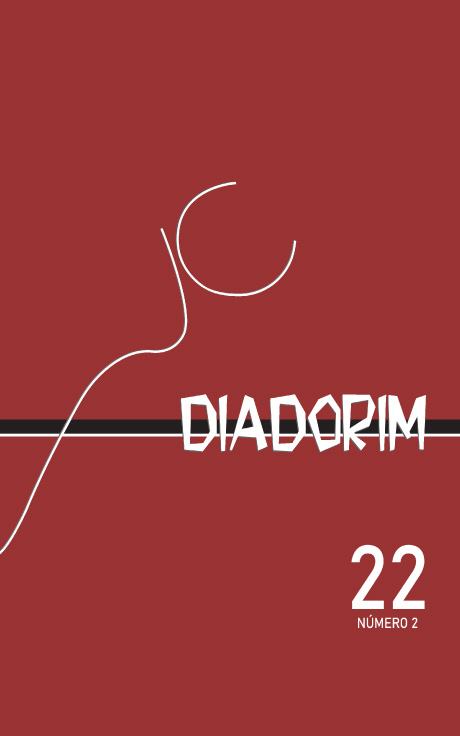A semantic analysis of the fire radical in chinese
DOI:
https://doi.org/10.35520/diadorim.2020.v22n2a39308Palavras-chave:
Chinese Character, Fire Radical, Global Extension, Prototype, Radial Network.Resumo
Fire has played an essential role in human civilization. FIRE as such is not only a basic but also a crucial concept in human language, including Chinese. In Chinese, FIRE huǒ火 acts as an independent character that is often used as a radical in many composite characters. Considering the fact that Chinese radicals are typically regarded as the semantic components within the composite characters to indicate broader concepts and categories of the characters, the FIRE radical is expected to determine the lexical meaning of composite characters one way or another. Since the independent use of the FIRE character precedes its function as a radical, we hypothesize that the semantic development of the FIRE radical will be influenced by those of the FIRE character. Therefore, we first carried out a semantic analysis of the FIRE character in previous research. The present paper studies the semantic structure of the global extensions of the FIRE radical, i.e. the original senses of the composite characters of the FIRE radical that are expected to have developed from the senses of the FIRE character. This analysis shows that, like the FIRE character, the semantic structure of the FIRE radical is still a radial network with prototypical features. However, the FIRE radical showcases semantic developments that occur independently of the FIRE character.
Referências
CHEN, R. Water networks, the Chinese radical, and beyond. In.: LI, T. F. (eds.), Compendium of Cognitive Linguistics Research (Language and Linguistics), Vol. 1, 91–115. New York: Nova publishers, 2012.
CHEN, Z. 阴阳五行[Yin-yang and five elements]. In.: WENTAO, J. (eds.),家庭医学全书 [Family medicine], 997–1002. Shanghai: Shanghai Science and Technology Press, 1989.
GEERAERTS, D. (eds.). Prospects and problems of prototype theory (Thematic issue of Linguistics). Berlin: Mouton de Gruyter, 1989.
______. Diachronic prototype semantics. A contribution to historical lexicology (Oxford Studies in Lexicography and Lexicology). Oxford: The Clarendon Press, 1997.
______. Words and other wonders: Papers on lexical and semantic topics (Cognitive Linguistics Research 33). Berlin: Mouton de Gruyter, 2006.
______. Family resemblances, radial networks, and multidimensional models of meaning. In.: FRIEND, M. L.; VAZ, P. R.; SANTANO, S. H. & CASANOVA, J. (eds.), Proceedings of the XXX AEDEAN Conference, 1–11. Huelva: Servicio de Publicaciones de la Universidad de Huelva, 2007.
HUANG, D., GEERAERTS, D. & ZHANG, W. A. Diachronic Analysis of the FIRE Character. Chinese Semiotic Studies, forthcoming.
JIANG, S. 古汉语词汇纲要 [Essentials of Ancient Chinese Lexical Semantics]. Beijing: Peking University Press, 1989.
JIANG, S. 汉语历史词汇学概要 [Essentials of Historical Chinese Lexicology]. Beijing: The Commercial Press, 2015.
LUO, Z. (eds.). 汉语大词典 [The great dictionary of Chinese], Vol. 7. Shanghai: Publishing House of The Great Dictionary of Chinese, 1991.
QIU, X. 文字学概要 [Essentials of Chinese Philology]. Beijing: The Commercial Press, 1988.
ROSCH, E. & MERVIS, C. B. Family resemblances: Studies in the internal structure of categories. Cognitive Psychology 7. 573–605, 1975.
WANG, N. 汉字构形学导论 [Introduction of Chinese characters formation]. Beijing: The Commercial Press, 2016.
WANG, W. 汉语核心词的历史与现状研究 [Research on the history and current situation of Chinese core words]. Beijing: The Commercial Press, 2018.
WANG, Y. 中古汉语词汇史 [History of Ancient and Middle Chinese lexical]. Beijing: The Commercial Press, 2010.
XU, S. 说文解字 [An analysis and explanation of characters]. Beijing: Zhonghua Book Company, 1963.
XU, Z. (eds.). 汉语大字典 [The great dictionary of characters], Vol. 3. Chengdu: Xinhua Winshare Publishing, 1988.
YANG, H. The semantic categorization of radical “辵” (chuò) in ShuoWenJieZi (《說文解字》).US–China Foreign Language 15(7). 429–436, 2017. https://doi.org/10.17265/1539-8080/2017.07.003.
YEH, S., CHOU, W. L. & HO, P. Lexical processing of Chinese sub-character components: Semantic activation of phonetic radicals as revealed by the Stroop Effect. Scientific Reports 7(1). 15782, 2017. https://doi.org/10.1038/s41598-017-15536-w.
YIN, J. J. Chinese characters. In.: SIN-WAI, C.; MINETTE, J. & WING YEE, F.L. (eds.), The Routledge Encyclopedia of the Chinese Language, 53–63. Abingdon and New York: Routledge, 2016.
YU, N. The Chinese HEART in a cognitive perspective: Culture, body, and language (Applications of Cognitive Linguistics 12). Berlin: Mouton de Gruyter, 2009.
ZHANG, F. . 汉语液体核心词研究 [Research on Chinese core words of LIQUIDS]. 江汉大学中国语言学学术文库 [The Collection of Chinese Linguistic Studies of Jianhan University] 1. Beijing: China Social Sciences Press, 2017.
Downloads
Publicado
Edição
Seção
Licença
Transferência de direitos autorais - Autorização para publicação
Caso o artigo submetido seja aprovado para publicação, já fica acordado que o autor autoriza a UFRJ a reproduzi-lo e publicá-lo na Diadorim: Revista de Estudos Linguísticos e Literários, entendendo-se os termos "reprodução" e "publicação" conforme definição respectivamente dos incisos VI e I do artigo 5° da Lei 9610/98. O artigo poderá ser acessado pela internet, a título gratuito, para consulta e reprodução de exemplar do artigo para uso próprio de quem a consulta. Essa autorização de publicação não tem limitação de tempo, ficando a UFRJ responsável pela manutenção da identificação do autor do artigo.

A Revista Diadorim utiliza uma Licença Creative Commons Atribuição-NãoComercial 4.0 Internacional (CC BY-NC 4.0).

